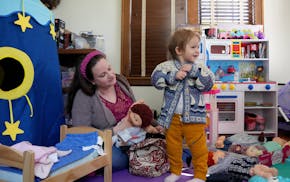As Timberwolves fans made the cold trudge up 1st Avenue N. for Wednesday evening's game, many paused for a curious glance through the glowing window of the Kickernick Building, where hundreds of art aficionados strolled through downtown Minneapolis' new fine arts gallery.
The red brick building was hosting a red carpet event to launch its new show and invite the public into the studios of 13 local artists, who over the past few months have moved into the historic Warehouse District property that was once at the epicenter of the city's art scene.
A year ago, the seven-story Kickernick sold for $3.79 million, a huge discount; it last sold in 2017 for $19.15 million. The COVID-19 pandemic was hard on the mixed-use property at 430 N. 1st Ave. and many of its neighbors, which saw storefronts shutter and office tenants leave.
The Kickernick's bargain price and 99% vacancy provided a blank canvas for new owner Kristi Oman of Space Unlimited, a family-run commercial property manager and developer with more than 1 million square feet of space in Minneapolis. Inspiration struck Oman during a June trip to New York, where she stayed in a hotel next to an EDEN contemporary fine art gallery.
"It made the entire building shine," Oman said. "We hadn't found the perfect tenant for this corner, so I thought: What if we did a fine art gallery there?
"As landlords, that's not something we usually do — put our own businesses in."
But she said the hope was the gallery would beautify the building and street, and attract artists. "It just exploded from there," Oman said.
Artist Emily Donovan was happily leasing studio space in Northeast Minneapolis' popular Northrup King Building when the Kickernick selected her work for its first show in September. Around the gallery's opening, she saw a second-floor studio with tall ceilings, exposed brick, tons of space and an in-room sink, a luxury her former space lacked. She quickly signed on as Oman's first artist tenant.
"This was basically my dream space," Donovan said. "But I also love the buildings and the architecture and overall vibe down here."
Fellow artists Harriet Bart and Jil Evans soon came over from the North Loop's Traffic Zone building, which was about to raise rents following an ownership change. The move marked a homecoming of sorts for Bart, who had worked out of a fourth-floor studio in the Kickernick early in her career.
"I remember 1st Avenue N. in the heyday of the '70s and '80s," Bart said. "There were thousands of people going up and down the street for the gallery scene."
She and others are hoping a post-pandemic real estate reset in the Warehouse District will bring artists back to the downtown corridor and make it a national cultural destination once again.
"We're counting on a 1st Avenue renovation, restoration, rejuvenation," Bart said. "With Kristi leading the pack."
The last renaissance
Long before the artists arrived, the Warehouse District housed Midwest wholesale operations for East Coast enterprises. The Kickernick Building was constructed in 1896 for a boot and shoe company, but it soon became home to garment makers producing women's lingerie.
The core of the Warehouse District, roughly 13 blocks linking the North Loop to downtown's central business district, declined as commercial and industrial activity shifted to the suburbs in the mid-1900s. In her book "Gallery Days," Judith Stern, whose former gallery got its start in the Kickernick, suggested the area's artist-led renaissance began around 1977 with the opening of mainstays like the New French Café and the Hanson-Cowles Gallery.
In the decade that followed, artists flocked to the Warehouse District, drawn to its architectural charm and tight-knit community.
"It was a beautiful, rich experiment that originated from the hearts and minds of local independent individuals with far more ambition and dreams than money," Stern wrote. "In the end, it may have been a victim of its own success."
Bart said much of the galleries' business was fueled by corporate art curators, who would outfit regional businesses with works from local artists. That became less common as the years passed, and the final blow came when Target Center and Interstate 394 opened in the early 1990s. Rents jumped; galleries became sports bars, and artists moved elsewhere.
The artists' return?
The pandemic tore a hole in commercial real estate markets, especially in downtowns, as workers went remote and offices downsized or closed. That left the Warehouse District poised, perhaps, for another new era.
Space Unlimited's discount on the Kickernick made it possible to keep rents lower than what it offers in northeast Minneapolis — under $1,000 a month for some spaces. Though Oman didn't have much past experience working with artists, she became their passionate advocate, pledging to keep rates at the Kickernick affordable.
The gallery surpassed expectations, selling more than $40,000 worth of art in its first few months. Only local artists will be featured, with some more affordable prices in the mix. More than 100 artists submitted for 11 spots in the new show.
The building is one-third full. Plans call for additional studio space to be opened on the fourth floor this year.
Though Oman estimates 75% of her potential showings are for artists, the Kickernick houses a variety of creative, small-business tenants, including advertising media and tattooists. An Indian restaurant and cocktail bar fill ground-floor storefronts, and Space Unlimited plans to open a 10,000-square-foot event space in the lower level.
When artist Kelsey Anderson started renting space at the Kickernick, her husband moved his law practice into an adjacent office. She said she's been pleasantly surprised at the popularity of classes she's taught at her studio that have drawn people downtown from the metro suburbs and beyond.
"We want people to talk about this place, to realize that we're here and we're here to stay," Anderson said. "There's so much potential. It takes people like Kristi with a vision, and money, to just say: We're doing this. And we're committing to it."
In recent months, public- and private-sector leaders have homed in on the Warehouse District as a key to downtown revitalization efforts. First Avenue N. is slated for a major reconstruction that could re-imagine the corridor in the coming years. Mayor Jacob Frey said the district has the potential to be Minneapolis' version of Times Square, a social district that attracts visitors from across the state.
Addressing the Kickernick crowd on Wednesday, Frey asked: "Who better to inspire that change, to make us think outside the box, to challenge us on our own beliefs, and to make us perhaps have a different perspective than artists?"

White House $5K 'baby bonus' would do little to offset cost of raising a kid in Minnesota

Meet the 'passionate person' it takes to care for Como Zoo's lemurs, sloths and orangutans

Ramstad: New U.S. Bank CEO impresses with dedication to 'keep the mission, pick up the pace'
Department of Government Efficiency causing confusion about when to claim Social Security

